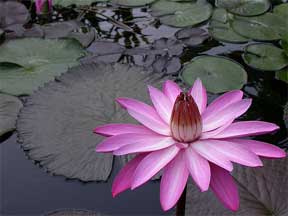If heavy April showers threaten to delay planting in the Midwest, the excess moisture can be soaked up and the soil made workable by spreading a 4-inch layer of vermiculite or peatmoss over the wet soil and allowing it to remain there for a day or two. This, of course, wouldn’t be practical for a large area but for the small seed bed, where early sowing is all important, this trick is invaluable.
Sow hardy and half-hardy annuals and vegetables as soon as possible. It isn’t too early to sow some of the tender varieties, and even if a few are lost, the gardener will be out very little, for we can sow them again. Put in a row or two of early snap beans. treating the seed first with a seed protectant so it will not rot in the cold soil.
An early planting, if it survives, will often bear a week or two ahead of those sown at the regular season. Also put in a few rows of hybrid sweet corn. The hybrids are somewhat resistant to fungus diseases, which are active in a cold soil.

Finish planting nursery stock as soon as possible and wrap the stems of newly set trees with burlap or paper nursery wrap to prevent sun scald. Trees that have been moved from the nursery row are especially susceptible to injury. since they are usually shaded and therefore protected while growing in the row. Woody plants with “slip” bark such as cherry, magnolia and plum are best moved at this time. lf not planted now, a whole year will be lost. for they should not be transplanted in the fall.
Dormant sprays for control of those insects which have lived over the winter on shrubs and trees may be applied from now to the time when the bud sheaths begin to open. But once a hairline of green appears on the buds, it is too late. Also, finish pruning before growth starts, if possible.
This is the last call for reseeding old lawns and seeding new ones. After the last week in April, grass seed will need special care to survive in the bright sun.
Early Planting of Glads
Earliest plantings of gladiolus corms can be made this month. Even if the soil in the bed freezes, the corms will survive and produce blooms earlier than those planted in May. Before planting the corms, dust them with a combination material containing a fungicide to prevent rot and an insecticide such as malathion to control thrips.
Turn over the compost heap before the warm weather arrives and “sugar” it lightly with a complete fertilizer. These two practices will speed up bacterial activity and thus hasten the decay of the composted leaves and other materials.
Tuberous begonias that were started earlier should be making good growth by now. If they are becoming lanky, move them to a cooler place, where the temperature is about 50°. This principle of keeping light, heat, moisture and food in balance should be applied to all indoor gardening, especially to growing seedlings and starting bulbs. Usually high temperature and low light intensity upset the balance. If the temperature and the water supply are reduced, the growth factors will be more nearly balanced.
Transplant all perennials except these blooming early in spring as soon as possible; these should be moved soon after flowering. Although it is sometimes recommended to transplant cabbage, cauliflower and broccoli as soon as possible, there is really no advantage in doing this. The cold weather merely hardens the fiber of the plants, lowering their eating quality. If possible, postpone transplanting of these vegetables until the apple blossoms have dropped their petals.
Start Tomato Plants
April 1 is traditionally the date for starting tomato plants indoors for later transplanting to the garden. Peppers and eggplant should have been seeded earlier; however, it’s not too late to get these crops started. Joseph’s coat or Amaranthus tricolor, after being all but forgotten for years, has suddenly become popular again in the Midwest. Its bronze, yellow, red and green foliage makes a spectacular show in our summer heat. Seed can be sown directly in the garden when the first tulips flower.
Sowing perennial seeds in June has long been advised, but this recommendation is based on English practice and cannot be followed successfully in the United States where summer is hotter and drier than it is in England. Instead, sow the seeds as early as the soil can be worked. The seedlings will be sturdier if they are sown during cooler weather.
Hardy water-lilies can be set out this month. Do not plant the tropical varieties until June 1, except in the area near the Ohio River, where planting is possible by May 15.
